CARunderscore
Structural
- Nov 12, 2015
- 28
I have an unusual precast wall design that might need out-of-plane shear reinforcement. I might be able to use #3 bars, but I'm already in pencil-sharpening mode, and single-leg deformed wire stirrups look like they might be a hypothetically better option due to a need to keep congestion down within a constrained thickness of wall. I've never seen any such thing before, but neither have I encountered my current set of design constraints before.
Here are the code requirements as I understand them (ACI 318).
[ul]
[li]Shear stirrups are allowed to be single-leg.[/li]
[li]Deformed wire is a permissible stirrup type.[/li]
[li]Stirrups are a permissible type of shear reinforcement for one-way "slabs"... which this essentially is from an analytical perspective. ACI is silent about out-of-plane reinforcement for "walls".[/li]
[li]Acceptable anchorage for a deformed wire stirrup is a "standard hook" that encloses a longitudinal bar.[/li]
[/ul]
Questions:
1. Am I off-base on any bullet points above?
2. Are loose (not in a mat/mesh) deformed wires something that can be reasonably purchased? Not readily, just reasonably. Custom orders are acceptable.
3. What the heck is a "standard hook" for a deformed wire? ACI's tables only list bar sizes, though I see no technical reason that I can't assume that the "No. 3 through No. 5" case should just read "No. 5 and smaller bars/wires".
Here are the code requirements as I understand them (ACI 318).
[ul]
[li]Shear stirrups are allowed to be single-leg.[/li]
[li]Deformed wire is a permissible stirrup type.[/li]
[li]Stirrups are a permissible type of shear reinforcement for one-way "slabs"... which this essentially is from an analytical perspective. ACI is silent about out-of-plane reinforcement for "walls".[/li]
[li]Acceptable anchorage for a deformed wire stirrup is a "standard hook" that encloses a longitudinal bar.[/li]
[/ul]
Questions:
1. Am I off-base on any bullet points above?
2. Are loose (not in a mat/mesh) deformed wires something that can be reasonably purchased? Not readily, just reasonably. Custom orders are acceptable.
3. What the heck is a "standard hook" for a deformed wire? ACI's tables only list bar sizes, though I see no technical reason that I can't assume that the "No. 3 through No. 5" case should just read "No. 5 and smaller bars/wires".


